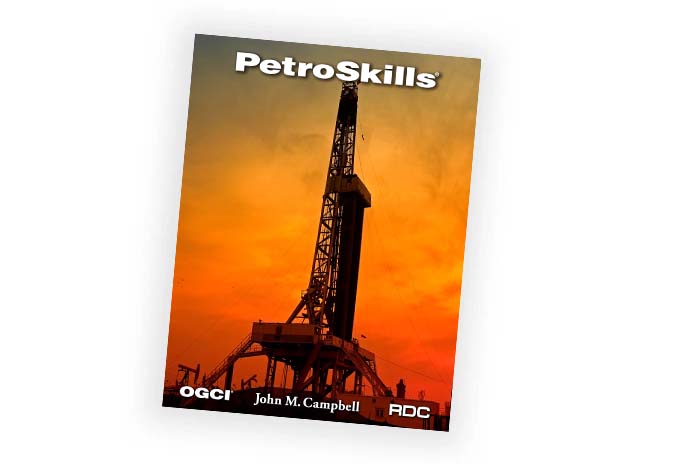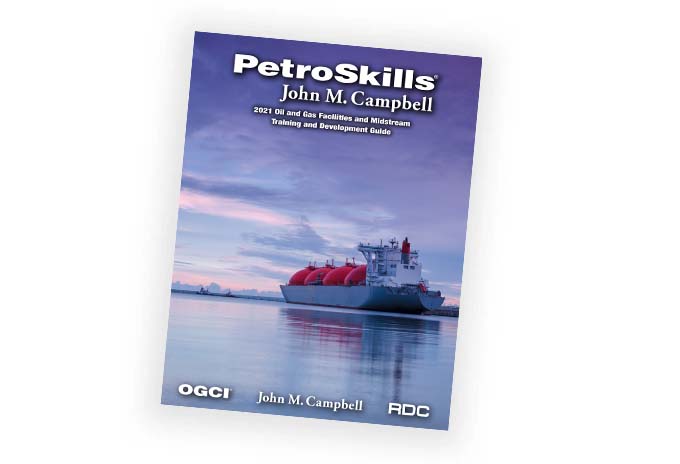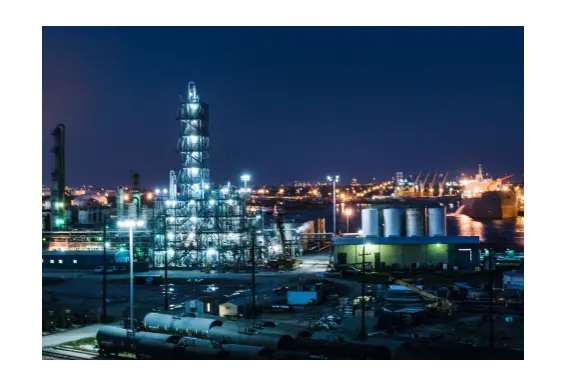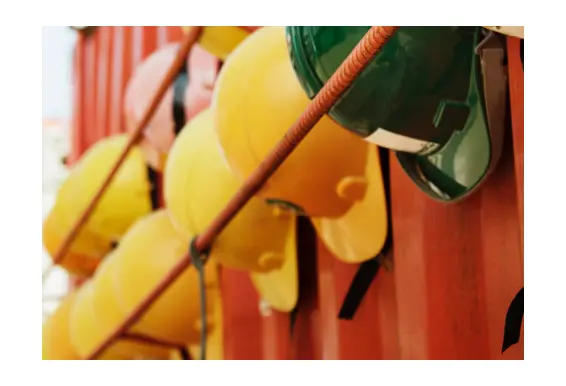Production Operations 1 - PO1 - Virtual + eLearning series
About the Course
This workshop will be delivered virtually through PetroAcademy. Each PetroAcademy offering integrates multiple learning activities, such as reading assignments, self-paced e-Learning, virtual instructor-led sessions, discussion forums, group exercises, case studies, quizzes, field trips, and experiential activities.
See detailed schedule and PetroAcademy details.
Activities include 22 hours of instructor-led, virtual training sessions, plus approximately 87 hours of self-paced work.
In addition to the scheduled sessions, this course is available on demand, wherein the course work is self-paced and instructor-led sessions are available any time as videos.
The Production Operations Blended Program represents the core foundation series of PetroSkills production engineering curriculum. Participants will become familiar with both proven historical production practices as well as current technological advances to enhance oil and gas production. Applied skills guide the participant within a framework to make careful, prudent, technical oil and gas business decisions.
In addition to online course materials, participants are able to purchase a hard copy of the textbooks prior to the course.
Target Audience
Engineers starting a work assignment in production engineering and operations, Production operations staff, Reservoir engineers, Facilities staff, Drilling and completions engineers, Geoscientists, Field supervisors, managers, and technicians, Service company engineers and managersYou Will Learn
-
Effects of depositional environment and the rock cycle in the formation of hydrocarbon accumulations
-
Reservoir engineering principles that guide optimum conventional and unconventional reservoir development
-
The important characteristics of oilfield Inflow and Outflow and their related mathematical flow equations and applied principles required for system modeling
-
Why a well flows on natural flow and the eventual requirement for artificial lift to maximize overall recovery as reservoir depletion occurs and reservoir energy diminishes
-
Special considerations for tubing regarding erosional velocity and critical flow conditions
WELL PERFORMANCE and NODAL ANALYSIS FUNDAMENTALS
-
Collect and validate required data to evaluate well performance using computer modeling and performance history matching, and predict potential problems
-
Calculate productivity index, and estimate basic reservoir parameters by interpreting a simple pressure buildup analysis in conventional and unconventional resources plays
-
Identify flow restrictions from basic inflow performance analysis, recommend actions to improve well productivity, and describe how to use choke equation calculations and its limitations
ONSHORE CONVENTIONAL COMPLETION
-
The purpose and basic operational aspects of wellhead, flow control equipment., and the major components used in a basic well completion in conventional plays
-
The impact that drilling practices may have on reservoir productivity
-
Describe the function and limitations of each surface and subsurface component of a basic onshore completions
-
Specify the production target of a well, and describe the type of completion or workover design components required to achieve the target
-
Describe the basic properties of completion components materials and their limitations in conventional resources plays
-
Describe which fluid systems are the most important for implementing successful completions and workovers in wells in conventional resources plays
-
Describe the most common subsurface equipment components used in conventional resources plays wells, and what they are used for
-
Describe the most relevant steps for implementing completion procedures in wells in conventional resources plays, and the proper interaction with all parties involved required
-
Describe the most relevant aspects of HSE in completion operations
-
Describe how a well flows, the impact of well control on fluid flow, and the most common control and monitoring devices
-
Describe the basic requirements and local regulations to abandon conventional wells
-
Specify the production target of a horizontal well, and describe the type of completion or workover design components required to achieve the target in conventional and unconventional resources plays
ONSHORE UNCONVENTIONAL COMPLETION
-
Describe the purpose and basic operational aspects of wellhead and flow control equipment in wells in unconventional plays
-
Describe the purpose of each of the major components used in a basic well completion in unconventional resources plays, and the impact that drilling practices have on reservoir productivity
-
Describe the function and limitations of each surface and subsurface component of a basic onshore completion in unconventional resources plays
-
Describe the basic properties of completion components materials and their limitations in unconventional resources plays
-
Describe which fluid systems are the most important for implementing successful completions and workovers in wells in unconventional resources plays
-
Describe the most relevant steps for implementing completion procedures in wells in unconventional resources plays, and the proper interaction with all parties involved required
-
Describe the most common techniques used to drill, complete, stimulate, and produce typical wells in coalbed methane reservoirs
PRIMARY and REMEDIAL CEMENTING
-
The manufacturing processes to blend composite materials that make up oilfield cement
-
The various uses of additives to modify cement properties
-
The cementing tools at the surface and downhole and the related cement displacement process to achieve a quality primary cement job to isolate a casing string
-
The casing cement evaluation tools and methods to assess cement job quality
-
The various practices that comprise options to attempt repair of primary cementing jobs that are referred to as cement squeeze operations
-
How to calculate typical casing string cement volume requirements
-
How to evaluate a cement bond log and make recommendations
PERFORATING
-
Discuss various shaped charges, their design, performance, shot phasing and shot density options, and their advantages and limitations
-
Illustrate the three primary perforating gun conveyance systems and the various gun types available and their individual features
-
Understand concepts like perf tunnel damage, gun standoff, underbalance, gun correlation on depth, and other engineering input requirements for each perforating job design
ROD, PCP, JET PUMPS, PLUNGER LIFT
-
How to evaluate reservoir and well conditions to choose the appropriate artificial lift system for each set of conditions
-
How rod pump, PCP pump, jet pump, and plunger lift artificial lift systems work
-
How to design and optimize rod pump, PCP pump, jet pump, and plunger lift completions
-
Why surveillance and monitoring of artificial lift systems is essential
-
Various API and related design standards and practices that represent key, proven artificial lift system performance fundamentals
RECIPROCATING ROD PUMP FUNDAMENTALS
-
Apply the working principles and operating characteristics of oilfield reciprocating rod pump artificial lift technology
-
Employ the steps necessary to design, maintain, and service rod pump surface unit equipment
-
Employ the steps necessary to design, maintain, and service rod pump rod strings
-
Employ the steps necessary to design, maintain, and service rod pump downhole pumps
-
Develop engineering and operating skills to successfully design, properly set up, maintain, and provide overall service for implementing and applying reciprocating rod pump artificial lift technology
-
Illustrate using pictures, animations, sketches, design software, and other media and tools the key mechanisms of rod pump systems
-
Design a rod pump rod string using the Modified Goodman method
-
Highlight the considerations and adjustments being reviewed by API regarding standards for proper consideration of rod fatigue and related corrosion effects upon rod string design
-
Work several rod pump design exercises to assess maximum and minimum pump load, minimum and maximum rod stress, motor selection, strokes per minute, stroke length, and related overall rod pump design parameter selection
-
Describe how a rod pump surface dynamometer gathers rod pump loading data over each pump cycle, calculate maximum and minimum rod stress loading, predict downhole pump performance, select rod string taper sizing, select motor horsepower required, and evaluate overall pump performance while identifying rod pump problems, all using a rod pump dynamometer, known as The Analytic and Predictive Tool for reciprocating rod pumps
-
Outline the primary causes of rod failure and how the use of rod guides and other auxiliary equipment can mitigate failures, the effect of gear box overload and how to prevent it, the proper selection of rod metallurgy for corrosion conditions, and the need for disciplined inspection of well tubing and rods to minimize failures
-
Demonstrate how the use of modern instrumentation “smart well” systems to control pump operation, gather data, and manage pump functions results in optimum pump performance and minimized costs
GAS LIFT and ELECTRICAL SUBMERSIBLE PUMP
-
Why artificial lift is required to maximize ultimate recovery
-
How to evaluate reservoir and well conditions to choose the appropriate artificial lift system for each set of conditions
-
How each artificial lift system works
-
How to design and optimize gas lift and ESP completions
-
Why surveillance and monitoring of artificial lift systems is essential
-
Various API and related design standards and practices that represent key, proven artificial lift performance fundamentals
GAS LIFT FUNDAMENTALS
-
Explain situations when gas lift is appropriate
-
Calculate the production rate and the flowing bottom-hole pressure from inflow performance analysis in a well completed with a gas lift system
-
Calculate the gas lift rate and pressure required to produce the well at a stable flow for various tubing sizes
-
Select the appropriate tubing size for a well to be completed with a gas lift system
-
Calculate the production rate and flowing bottom-hole pressure using widely accepted techniques applicable to unconventional resources wells completed with a gas lift system
-
Design a gas lift installation with the required number of unloading mandrels, charge pressure, and orifice size lift valves at the appropriate spacing based on available gas lift pressure and required lift rate for conventional and unconventional resources
-
Operate, troubleshoot and optimize gas lifted wells and network systems
ELECTRICAL SUBMERSIBLE PUMPS
-
Calculate the production rate and the pump intake pressure from inflow performance analysis
-
Calculate the free gas and fluid viscosity at pump intake conditions
-
Determine the pump capacity and motor horsepower required to deliver the desired flow or rate limited by the ESP equipment
-
Determine the power cable type and gauge based on formation parameters
-
Ensure ESP equipment failure data is properly documented
-
Review failure trends
-
For an ESP design, select the appropriate protector for a given application
-
Calculate the production rate and pump intake pressure using widely accepted techniques applicable to unconventional resource wells
-
Determine the pump capacity and motor horsepower required to deliver the desired production rate in unconventional resource wells
FORMATION DAMAGE and MATRIX STIMULATION
-
The basic causes of oilfield formation damage and how they are recognized
-
The concept of “True Formation Damage” and the principles of formation remediation once it has been correctly identified as being the cause of lost production
-
How “pseudo” damage and differs from True Formation Damage
-
The principles of limestone matrix acidizing and the chemistry and reactions involved
-
The principles of sandstone matrix acidizing and the chemistry and reactions involved
-
Formation damage identification and the positive results achieved by successfully conducting matrix acidizing jobs
FORMATION DAMAGE and MATRIX ACIDIZING FUNDAMENTALS
-
Illustrate the impact of formation damage upon production
-
Explain the wide variety of reasons, sources, depositional environments, and routine operations’ activities that result in production limitations
-
Assess formation damage “skin” values
-
Calculate production rates with various levels of formation damage as well as no formation damage
-
Describe how TFD is recognized and how PD is recognized and present the characteristics and elements of each
-
Illustrate clay stabilization through the use of positively charged cation exchange to stabilize negatively charged clays to limit clay migration, hydration, and other damaging mechanisms
FLOW ASSURANCE and PRODUCTION CHEMISTRY
-
Typical oilfield “flow assurance” issues and problems due to: waxes, asphaltenes, inorganic scales, and corrosion
-
How to interpret revealing signs of corrosion and erosion failure, scale formation, and related downhole deposits and how to prevent or minimize their production loss effects
-
How formations become damaged due to related flow assurance and production chemistry issues
-
The importance of collecting data to categorize options to choose an optimum well prevention and treatment plans
-
How to recognize, prevent, remove, and manage organic paraffin and asphaltene field deposits
-
How to recognize, prevent, remove and manage typical common soluble and insoluble scales in oil and gas operations
-
The importance of using oilfield production chemistry to resolve production problems
-
The conditions required for the formation of gas hydrates
-
How ice crystals and methane in pipelines can lead to severe plugging of lines if not prevented from occurring or regularly removed by pigging operations
-
The methods employed to treat gas hydrates in pipelines
SAND CONTROL
-
Identify the need for sand control
-
Recognize the causes of sand movement
-
Define what consolidated sand is, and what it is not
-
Identify both non-mechanical and mechanical methods of sand control
-
Recognize that rate restriction is a valid practice to manage sand production
-
Recognize that minor sand volume produced may be tolerated
-
Identify various screen types for sand control
-
Outline aspects of pre-packed screens for sand control
-
Describe the principles of sand control screen and gravel completions
-
Identify the three steps comprising a gravel pack completion design
-
Describe various fluid options for pumping gravel slurry into a gravel pack completion
-
Outline the function of a gravel pack “crossover tool”
-
Outline the function of a gravel pack “shunt tube”
-
Describe the function of a frac pack completion
-
Outline the frac pack completion well performance results
-
Outline the function of an expandable sand screen completion
-
Identify the components of an expandable screen and possible benefits resulting from the use of expandables
SAND CONTROL FUNDAMENTALS
-
Design and execute fracpack treatments in basic situations
-
Use at least one commercial fracturing design model to perform specific calculations related to fracpacking such as, fluid efficiency, net pressure, closure pressure, bottom hole treating pressure, and friction. Interpret basic pressure information during minifrac or main frac in a fracpack operation
-
Analyze data used for fracpack design purposes to ensure they are appropriate and sensible
-
During a fracpack, describe the advantages and limitations of inducing a tip screen-out
-
Design and obtain Tip Screenouts
HYDRAULIC FRACTURING (CONVENTIONAL and UNCONVENTIONAL)
-
Describe the significance of rock mechanics in all relevant production engineering operations
-
Describe the most common non-chemical stimulation methods, their objectives and limitations in conventional resources plays
-
Describe the most common non-chemical stimulation methods, their objectives and limitations in unconventional resources plays
-
Describe the basic principles of hydraulic fracturing in conventional plays, the difference between acid and proppant treatments, and how to select optimum stimulation candidates
-
Describe the basic principles of hydraulic fracturing in unconventional resource plays, the difference between slickwater and cross-linked treatments, and how to select optimum stimulation candidates
PRODUCTION PROBLEM DIAGNOSIS
-
Describe the different types of field collected data, and the most relevant factors that affect well performance in conventional and unconventional resources plays
-
Describe the difference between drill stem and production tests, when to select and apply each test, how to validate collected data, and the purpose of pressure buildup analysis in conventional and unconventional resources plays
-
Describe the effect of pressure on fluid flow, Inflow Performance Relationship analysis principles, and the best tubing correlations to use when modeling vertical and horizontal wells
-
Describe the importance of applying and complying with all requirements to ensure integrity throughout the life cycle of a well including potential well problems from thermal fluids
PRODUCTION LOGGING
-
Describe the purpose(s) of running cased hole production logs
-
Describe the types of data collected from logs, and the mechanics of running logs
-
Identify output from the most common production logs used
-
Describe conveyance methods for production logs in horizontal wells
-
Describe issues related to production log interpretation with poorly defined bed boundaries and complex fracture systems in ultra-low perm reservoirs
-
Describe cased-hole micro seismic techniques
PRODUCTION LOGGING FUNDAMENTALS
-
Interpret and determine the validity of data obtained from the most common production logs, such as spinner surveys, temperature logs, and gamma-ray in wells
-
Supervise logging jobs onsite, and make all necessary operational decisions to ensure job objectives are achieved
-
Use production logging results to identify well production problems and create remedial actions
Course Content
BLENDED LEARNING WORKSHOP STRUCTURE
This program is comprised of the following activities:
ILT = Virtual Instructor-led Training
OL = Online Learning Activity/Reading
| Week | Activity | Hours (Est.) | Subject |
Session 1 Virtual ILT Option 1 Perth, AUS timezone (GMT+8) |
Session 1 Virtual ILT Option 2 Houston, US timezone (GMT-5) |
Session 2 Virtual ILT Option 1 Perth, AUS timezone (GMT+8) |
Session 2 Virtual ILT Option 2 Houston, US timezone (GMT-5) |
|
ILT |
1.0 | Orientation Webcast (pre-recorded) | |||||
| Week 1 | OL | 4.0 | Production Principles | ||||
| Week 2 | ILT | 1.5 | Well Performance and Nodal Analysis Fundamentals - Session 1 | Monday, April 21, 08:00-09:30PM | Tuesday, April 22, 08:00-09:30AM | Monday, Sept 1, 08:00-09:30PM | Tuesday, Sept 2, 08:00-09:30AM |
| OL | 7.0 | Well Performance and Nodal Analysis Fundamentals | |||||
| ILT | 1.5 | Well Performance and Nodal Analysis Fundamentals - Session 2 | Wednesday, April 23, 08:00-09:30PM | Thursday, April 24, 08:00-09:30AM | Wednesday, Sept 3, 08:00-09:30PM | Thursday, Sept 4, 08:00-09:30AM | |
| Week 3 | OL | 4.0 | Onshore Well Completion - Conventional | ||||
| Week 4 | OL | 4.0 | Hydraulic Fracturing | ||||
| Week 5 | OL | 4.0 | Onshore Well Completion - Unconventional | ||||
| Week 6 | OL | 3.0 | Perforating | ||||
| Week 7 | OL | 3.0 | Sand Control | ||||
| Week 8 | ILT | 1.5 | Sand Control Fundamentals | Monday, May 19, 10:00-11:30PM | Tuesday, May 20, 08:00-09:30AM | Monday, Sept 29, 10:00-11:30PM | Tuesday, Sept 30, 08:00-09:30AM |
| OL | 4.0 | Sand Control Fundamentals | |||||
| ILT | 1.5 | Sand Control Fundamentals | Wednesday, May 21, 10:00-11:30PM | Thursday, May 22, 08:00-09:30AM | Wednesday, Oct 1, 10:00-11:30PM | Thursday, Oct 2, 08:00-09:30AM | |
| Week 9 | OL | 5.0 | Primary and Remedial Cementing | ||||
| Week 10 | ILT | 2.5 | Reciprocating Rod Pump Fundamentals | Monday, June 2, 08:00-09:30PM | Tuesday, June 3, 08:00-09:30AM | Monday, Oct 13, 08:00-09:30PM | Tuesday, Oct 14, 08:00-09:30AM |
| OL | 3.0 | Reciprocating Rod Pump Fundamentals | |||||
| ILT | 2.5 | Reciprocating Rod Pump Fundamentals | Wednesday, June 4, 08:00-09:30PM | Thursday, June 5, 08:00-09:30AM | Wednesday, Oct 15, 08:00-09:30PM | Thursday, Oct 16, 08:00-09:30AM | |
| Week 12 | OL | 4.0 | Gas Lift and Electrical Submersible Pumps | ||||
| Week 13 | ILT | 1.5 | Gas Lift Fundamentals - Session 1 | Monday, June 16, 10:00-11:30PM | Tuesday, June 17, 08:00-09:30AM | Monday, Oct 27, 10:00-11:30PM | Tuesday, Oct 28, 08:00-09:30AM |
| OL | 4.0 | Gas Lift Fundamentals | |||||
| ILT | 1.5 | Gas Lift Fundamentals - Session 2 | Wednesday, June 18, 10:00-11:30PM | Thursday, June 19, 08:00-09:30AM | Wednesday, Oct 29, 10:00-11:30PM | Thursday, Oct 30, 08:00-09:30AM | |
| Week 14 | ILT | 1.5 | ESP Fundamentals - Session 1 | Monday, June 23, 10:00-11:30PM | Tuesday, June 24, 08:00-09:30AM | Monday, Nov 3, 09:00-10:30PM | Tuesday, Nov 4, 08:00-09:30AM |
| OL | 3.0 | ESP Fundamentals | |||||
| ILT | 1.5 | ESP Fundamentals - Session 2 | Wednesday, June 25, 10:00-11:30PM | Thursday, June 26, 08:00-09:30AM | Wednesday, Nov 5, 09:00-10:30PM | Thursday, Nov 6, 08:00-09:30AM | |
| Week 15 | OL | 3.0 | Formation Damage and Matrix Acidizing | ||||
| Week 16 | ILT | 1.5 | Formation Damage and Matrix Acidizing Fundamentals - Session 1 | Mionday, July 7, 08:00-09:30PM | Tuesday, July 8, 08:00-09:30AM | Monday, Nov 17, 07:00-08:30PM | Tuesday, Nov 18, 08:00-09:30AM |
| OL | 6.0 | Formation Damage and Matrix Acidizing Fundamentals | |||||
| ILT | 1.5 | Formation Damage and Matrix Acidizing Fundamentals - Session 2 | Wednesday, July 9, 08:00-09:30PM | Thursday, July 10, 08:00-09:30AM | Wednesday, Nov 19, 07:00-08:30PM | Thursday, Nov 20, 08:00-09:30AM | |
| Week 17 | OL | 5.0 | Flow Assurance and Production Chemistry | ||||
| Week 18 | OL | 3.0 | Production Problem Diagnosis and Intervention Planning | ||||
| Week 19 | OL | 3.0 | Production Logging | ||||
| Week 20 | ILT | 1.5 | Production Logging Fundamentals - Session 1 | Monday, Aug 4, 08:00-09:30PM | Tuesday, Aug 5, 08:00-09:30AM | Monday, Dec 08, 07:00-08:30PM | Tuesday, Dec 09, 08:00-09:30AM |
| OL | 3.0 | Production Logging Fundamentals | |||||
| ILT | 1.5 | Production Logging Fundamentals - Session 2 | Wednesday, Aug 6, 08:00-09:30PM | Thursday, Aug 7, 08:00-09:30AM | Wednesday, Dec 10, 07:00-08:30PM | Thursday, Dec 11, 08:00-09:30AM |
Product Details
Categories:
UpstreamDisciplines:
Production and Completions EngineeringLevels:
FoundationProduct Type:
CourseAdditional
Request a Public Session
If you are interested in a public session of this course, please click the button below to request it.
Request Public SessionIn-House Training
This course is also available upon request as a private, on-site seminar. Contact us for details and pricing.
Request In-House TrainingNeed Help
Contact us if you have additional questions about how to register for or attend this course.
Contact Us



